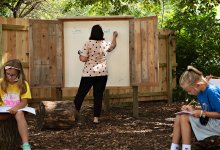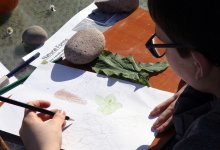Place-Based Learning
Location, location, location! See what happens when schoolwork explores students’ connections with local history, environment, culture, or economy.
4 Strategies to Maximize the Field Trip Experience
Design a real-world learning experience outside of the classroom with purpose; a field trip can be more than just a treat.2.9kYour content has been saved!
Go to My Saved Content.With Safety in Mind, Schools Take Classes Outdoors
There are plenty of logistics to consider, but educators say outdoor classes keep kids and teachers safer—and provide much-needed fresh air.257kYour content has been saved!
Go to My Saved Content.Boosting Midyear Engagement With Place-Based PBL
High school teachers can build projects around issues in the local community to motivate students before and after winter break.2.1kYour content has been saved!
Go to My Saved Content.Teaching a Citizen Science Project in High School
A biology teacher shares learnings and takeaways from the “controlled chaos” of her class’s first citizen science project.5.1kYour content has been saved!
Go to My Saved Content.5 Short Nature-Focused Activities for Young Students
Opportunities for outdoor learning don’t require special materials, and you can get started by dedicating just 10 minutes to the experience.5.8kYour content has been saved!
Go to My Saved Content.How to Make the Most of Loose Parts Play in Preschool
From counting and classifying to literacy lessons, teacher-tested learning opportunities that encourage autonomy and creativity.Using Nature to Introduce Math in Preschool
Young children can learn about math concepts through activities rooted in exploring the outdoors.Using Origami to Teach Children About Endangered Animals
As elementary students turn squares of paper into animals they’re studying, the age-old Japanese art form makes lessons more memorable.21.5kYour content has been saved!
Go to My Saved Content.Using Local Place Names to Teach History
These place-based learning ideas help high school students discover more about their community as they learn to use the historical method.Simple Ways to Bring Learning Outside
Going outside helps students focus, and activities for classes from social studies to math can incorporate the natural world.23.6kYour content has been saved!
Go to My Saved Content.Ramping Up Relevance With Community-Centered Learning
Community-based research projects can help upper elementary and middle school students see value in what they’re learning.1.9kYour content has been saved!
Go to My Saved Content.7 Tips for Moving Learning Outside
Though it can seem daunting, getting students outdoors for even 30 minutes offers many benefits. This checklist can help get you started.16.4kYour content has been saved!
Go to My Saved Content.Building a Sustainable Future—One Classroom at a Time
A mini-golf course, a canoe trip down the local river, a discussion about environmental justice. Here’s how schools are teaching students about environmental science.15.2kYour content has been saved!
Go to My Saved Content.A Handy Framework for Designing Units of Study
People, places, and problems offer rich opportunities for real-world learning. This unit design framework ensures engaging, aligned learning objectives, experiences, and assessments.8.5kYour content has been saved!
Go to My Saved Content.How Outdoor Education Can Shift Mindsets in the Classroom
This school leverages lessons from their on-campus ropes course to help students realize their full potential as part of a community of learners—and beyond.














